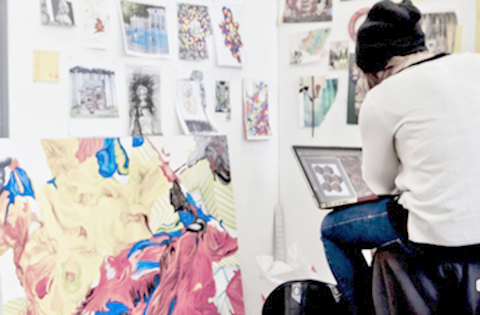Programs > Programs in the College of Art, Media, & Design
Contacts Description Program Objectives Program Requirements

Quick Links
Academic Plan
College of Art, Media & Design
School of Art
Liberal Arts Distribution
Contacts
Rebecca Sack \ rsack@uarts.edu \ 215.717.6496
Program Director
Description
Students in the Fine Arts Program are exposed to a wide range of both art historical precedents and contemporary art in order to realize that meaning is always specific to the form that is used to express it. The program fosters the understanding that choices in technique, process and format must be appropriate to the desired end results. Students develop a personal studio practice based on conceptual interests, technical advancement and expansion, and the appreciation that the personal, the cultural and the historical are interlaced.
The curriculum is based on a framework of research, studio experimentation, artistic invention, and daily practice. Personal vision and artistic innovation anchor the development of work for significant cultural contributions and dialog, gallery and museum exhibitions as well as creating work for diverse communities and public spaces. To that end, students will be given assignments designed to develop conceptual skills and become proficient in the necessary processes and techniques appropriate to their artistic vision and intention.
Student in the Fine Arts Program have multiple options. They can choose an emphasis in one of the following: Painting and Drawing, Printmaking and Book Arts, Sculpture, Photography, Film, Animation or Crafts (Wood, Ceramics, Metal and Jewelry, Fibers, Glass). Five required classes are taken in a chosen discipline. Using electives, the Fine Arts major can choose a broad field of study or they can choose to use their electives for deep emphasis in their chosen discipline.
Most semesters have the Fine Arts major taking one discipline specific class and one Interdisciplinary Commons class as their studio requirements, balancing the acquisition of discipline specific skills with conceptual development in a context that extends beyond a specific discipline.
Research into culturally important areas outside of the arts, such as, philosophy, psychology, history, sociology and science, are at the center of the curriculum along with critical thinking and visual analysis. Our emphasis on the liberally educated artist assures that our graduates will be knowledgeable beyond contemporary studio skills, be enabled and motivated to add something of value, not only to Art’s historical legacy, but to the broader contemporary context of serious human enterprise.
The senior thesis project/exhibition prepares each individual for successful entry into graduate-level programs, and to be competitive in gaining other forms of support, such as those available in grants, residencies, and gallery exhibitions. The program also addresses and prepares students for a variety of professional pathways related to their skill base and interests.
Program Objectives
- Students demonstrate independent, creative problem solving and original thinking through the development of a distinct and personal approach to art making informed by contemporary issues and historical precedents.
- Students demonstrate critical and conceptual development through research and analysis, applying readings, theories and methodologies toward the production of critically informed artworks.
- Students acquire and demonstrate the professional skills needed to be successful as practicing artists, entrepreneurs, and productive citizens, including further study at the graduate level.
- Students effectively communicate, orally and in writing, the thoughts behind their choices and decisions concerning content and strategies.
- Students demonstrate proficiency in a number of advanced techniques in their individual studio practice, including a deep familiarity with materials and processes.
Program Requirements (126 Credits)